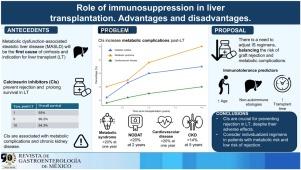Role of immunosuppression in liver transplantation. Advantages and disadvantages
Revista de gastroenterologia de Mexico (English)
Pub Date : 2025-07-01
DOI:10.1016/j.rgmxen.2025.09.008
引用次数: 0
Abstract
Cirrhosis of the liver is a major cause of death worldwide, with a recent increase in cases secondary to metabolic dysfunction-associated steatotic liver disease and alcohol use. Liver transplantation is currently the only definitive treatment but requires immunosuppression for preventing graft rejection.
Calcineurin inhibitors are the cornerstone of immunosuppression in transplanted patients. However, their use conditions metabolic and renal complications, such as metabolic syndrome, post-transplant diabetes, and chronic kidney disease. Minimizing or discontinuing immunosuppression has been shown to reduce those adverse effects in selected patients, especially those with potential immunotolerance. Predictors of immunotolerance and cardiovascular complications in transplanted patients have been identified in recent studies. Thus, there is a need for developing individualized strategies for balancing metabolic risk and graft rejection prevention.

免疫抑制在肝移植中的作用。优点和缺点。
肝硬化是世界范围内死亡的一个主要原因,最近继发于代谢功能障碍相关的脂肪变性肝病和酒精使用的病例有所增加。肝移植是目前唯一确定的治疗方法,但需要免疫抑制来防止移植排斥反应。钙调磷酸酶抑制剂是移植患者免疫抑制的基础。然而,它们的使用条件代谢和肾脏并发症,如代谢综合征,移植后糖尿病和慢性肾脏疾病。减少或停止免疫抑制已被证明可以减少某些患者的不良反应,特别是那些有潜在免疫耐受的患者。最近的研究已经确定了移植患者免疫耐受和心血管并发症的预测因素。因此,有必要制定个性化的策略来平衡代谢风险和移植物排斥预防。
本文章由计算机程序翻译,如有差异,请以英文原文为准。
求助全文
约1分钟内获得全文
求助全文

 求助内容:
求助内容: 应助结果提醒方式:
应助结果提醒方式:


